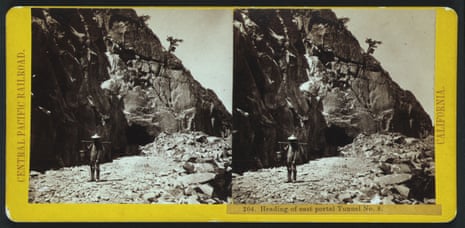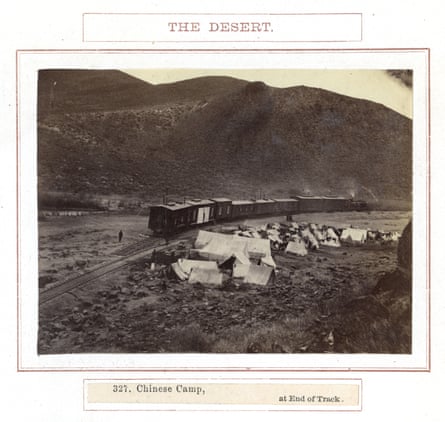| | | The Irish and the Chinese built the American rail system, am told, and might be wrong, or off, but it be what am told
agnostic to save bother of pointless debate
the back story << in my working life it's gone from Steam Trains and Paddy fields to a manufacturing and technology juggernaut >>
dada noted as much chinese of america jack chen

can get your copy here amazon.com
and there books.google.com.hk
This work has been selected by scholars as being culturally important, and is part of the knowledge base of civilization as we know it. This work was reproduced from the original artifact, and remains as true to the original work as possible. Therefore, you will see the original copyright references, library stamps (as most of these works have been housed in our most important libraries around the world), and other notations in the work.
This work is in the public domain in the United States of America, and possibly other nations. Within the United States, you may freely copy and distribute this work, as no entity (individual or corporate) has a copyright on the body of the work.
As a reproduction of a historical artifact, this work may contain missing or blurred pages, poor pictures, errant marks, etc. Scholars believe, and we concur, that this work is important enough to be preserved, reproduced, and made generally available to the public. We appreciate your support of the preservation process, and thank you for being an important part of keeping this knowledge alive and relevant. Jack Chen is the son of Eugene Chen, twice Foreign Minister of China under Sun Yat-sen. After many years of exile from China he was invited to return in 1950 by Mao Tse-tung, and lived there until recently, when, at the age of 63, he moved to Hong Kong. His 1971-72 series of articles in the "Far Eastern Review "and "New York Times "gave the first real news of the "516" conspiracy and other aspects of the cultural revolution in China. An extensive history of Chinese-Americans recounts their crucial role in founding wineries, building railroads, and mining gold, their contributions to ...
theguardian.com
'Forgotten by society' – how Chinese migrants built the transcontinental railroad
In a new exhibition, the overlooked contribution of Chinese workers is being brought to the light for the 150th anniversary of the railroad’s completion
Nadja Sayej

Tea carrier at tunnel, about 1867. Photograph: Courtesy of Library of Congress
When one thinks of the transcontinental railroad, rarely do Chinese migrants come to mind. But in a new exhibition at the National Museum of American History in Washington, a vital revision is presented.
Until spring 2020, Forgotten Workers: Chinese Migrants and the Building of the Transcontinental Railroad peels back the layers to see who else should be commemorated during the recent 150th anniversary of the transcontinental railroad’s completion – an achievement which has typically been celebrated with photos of old locomotives, successful-looking men in suits and anonymous workers hammering away.
But this exhibition takes a different tack, tracing the forgotten Chinese workers who built the western leg of the railroad across the Sierra Nevada mountains, connecting the Union Pacific and Central Pacific railroad in 1869.
“Historians have always known and written about the Chinese workers, but it’s forgotten by society,” said Peter Liebhold, who co-curated the exhibit with Sam Vong. “We’ve forgotten the contribution of these workers, and in fact, we forget the contribution of all workers. We tend to focus on the achievement of the few and not the stories of the average everyday person.”
It tells the story of Chinese workers through old maps, detailing where they worked, their labor materials – from conical hats to miner’s picks – and photos, showing the tents they lived in, their working conditions and their nomadic lifestyle.
“The artifacts on view are meant to help visitors understand how forgotten workers had to endure hazardous, unfair conditions, in addition to backbreaking labor,” said Leibhold. “The 150th anniversary is not just about completing a railroad, but the workers involved.”
From 1863 and 1869, roughly 15,000 Chinese workers helped build the transcontinental railroad. They were paid less than American workers and lived in tents, while white workers were given accommodation in train cars.

Camp, near Humboldt Wells, Nevada, about 1869. Photograph: Courtesy of Alfred A. Hart Photograph Collection, Stanford UniversityChinese workers made up most of the workforce between roughly 700 miles of train tracks between Sacramento, California, and Promontory, Utah. During the 19th century, more than 2.5 million Chinese citizens left their country and were hired in 1864 after a labor shortage threatened the railroad’s completion.
The work was tiresome, as the railroad was built entirely by manual laborers who used to shovel 20 pounds of rock over 400 times a day. They had to face dangerous work conditions – accidental explosions, snow and rock avalanches, which killed hundreds of workers, not to mention frigid weather.
“All workers on the railroad were ‘other’,” said Liebhold. “On the west, there were Chinese workers, out east were Irish and Mormon workers were in the center. All these groups are outside the classical American mainstream.”
The exhibition features a century-old pair of chopsticks, as well as canisters for tea and soy sauce. The railroad company provided room and board to white workers, but Chinese workers had to find their own meals, which were often brought to them from local merchants.
There are also miner’s picks and shovels, conical hats, as well as photos of the camp sites where the workers lived in Nevada in 1869. There are photos, as well, of the Native Americans, many of whom protested against the building of the railway in 1869, which displaced the Lakota, Shoshone, Cheyenne and other communities.
The Chinese workers were educated and organized; 3,000 laborers went on strike in 1867 to demand equal wages, as the white workers were paid double.
“They were unsuccessful because they were out in the middle of nowhere,” said Liebhold. “The railroad stopped them from getting food. That’s one way it failed.”
One telling photo on view is a shot of the Union Pacific board members sitting in a business class train car from 1869. By paying laborers a low wage, they were able to skim millions from the construction and get rich.

Railroad workers, about 1867. Photograph: New York Public Library/Courtesy of The New York Public Library“Building railroads is often profitable but operating them isn’t necessarily, if you look at the history of railroads in the US,” said Liebhold. “To totally condemn the businessmen is challenging because they took huge risks raising money to build a railroad that was astronomically difficult. Many people didn’t think it was possible.”
There is one photo from 1869 that shows how the company commemorated the last hammered spike to complete the railroad, however, only one Chinese worker is in the photo. Many of the actual workers were left out.
This story could still be one which resonates with today’s America. “There’s no question this is a story about migrant labor,” he said. “Chinese workers were not citizens, weren’t allowed to become citizens. From the 1850s to 1882, they were tolerated in the US, but not accepted as peers.
“Then, there was the Chinese Exclusion Act, which barred immigrants from coming into US, unless you were a diplomat or a businessperson,” said Liebhold. “You’re always welcome if you’re affluent, then you’re allowed to come in.” |
|








